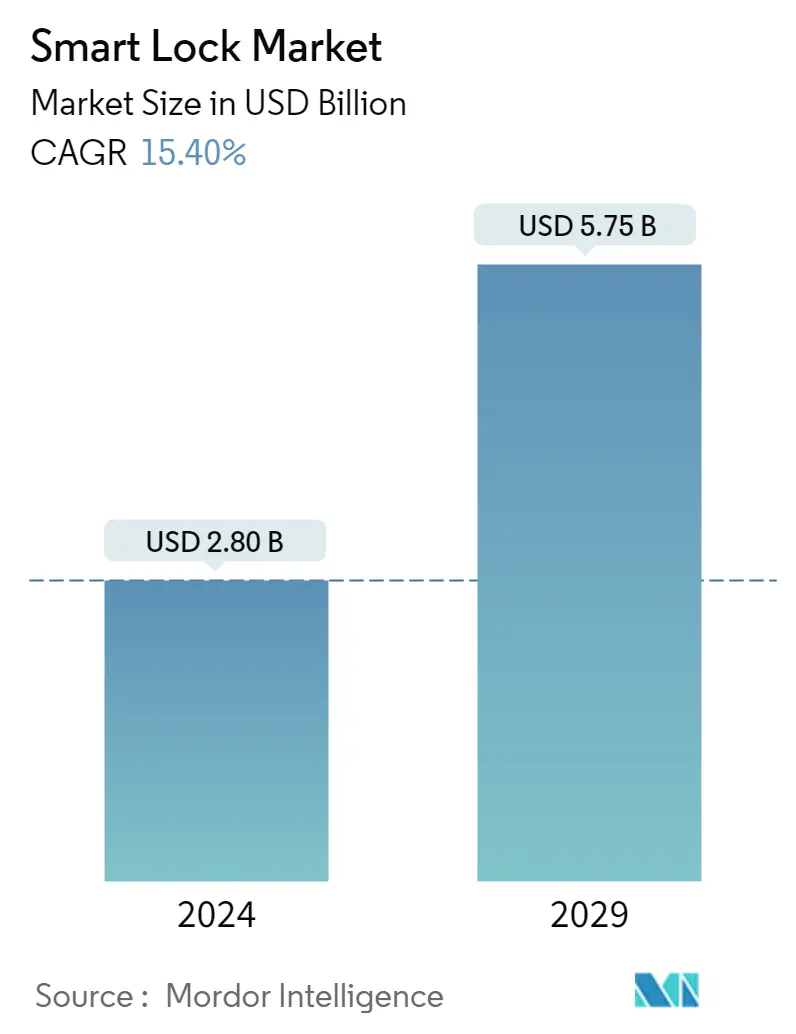Market Size of Smart Lock Industry

| Study Period | 2022 - 2029 |
| Market Size (2024) | USD 2.80 Billion |
| Market Size (2029) | USD 5.75 Billion |
| CAGR (2024 - 2029) | 15.40 % |
| Fastest Growing Market | Asia Pacific |
| Largest Market | North America |
Major Players
*Disclaimer: Major Players sorted in no particular order |
Need a report that reflects how COVID-19 has impacted this market and its growth?
Smart Lock Market Analysis
The Smart Lock Market size is estimated at USD 2.80 billion in 2024, and is expected to reach USD 5.75 billion by 2029, growing at a CAGR of 15.40% during the forecast period (2024-2029).
The increasing adoption of smart home architecture worldwide, including features like remote access, voice control, and seamless connectivity, is further propelling the adoption of smart locks for residential premises. Additionally, the eliminated need to carry the mechanical keys around has attracted the likes of residential owners.
- The expansion of smart home adoption on a global scale and the rise of businesses that offer home automation technology are further factors in the rising demand for smart locks. The industry's participants concentrate on developing cutting-edge techniques and commercially viable goods, such as remote locking and opening windows, doors, and doors.
- Additionally, manufacturers pair their products with such devices as the number of households with voice assistants increases steadily, enabling voice control of locks. Customers are anticipated to become more popular due to these advancements as they increasingly look for sophisticated and straightforward locking/unlocking solutions. A growing number of properties must be identified and certified, including individual homes, hotels, supermarkets, banks, financial institutions, corporate buildings, and commercial buildings.
- The increasing penetration of smartphones is also stimulating the growth of connected devices, which enable users to remotely access their door locks and unlock the doors using various related mobile apps. According to Oberlo, an e-commerce company, there are currently 3.5 billion smartphone users worldwide, and the penetration rate is approximately 45.4% of the global population of 7.7 billion people. Simply put, four out of every ten people in the world are currently equipped with a smartphone.
- Amid various driving factors, the growth of the smart locks market could face challenges, owing to the prevailing vulnerability to hacking and increasing threats of cybercrimes, as smart locks, in particular, is a popular target for cybercriminals. For instance, in July this year, According to security researchers with NCC Group, there were 11 security problems affecting Nuki intelligent lock systems, including ones that could let intruders unlock doors. Such instances instill a sense of insecurity among casual users.
- The COVID-19 pandemic has led to a nosedive in investments in the ICT industry, particularly in the Internet of Things, 5G technologies, and other emerging technologies. Players in the smart lock market are forced to restrict their operational expenses. They have witnessed a reduction in hiring and capital budgets as well. Moreover, discretionary consumer spending in this scenario has also lowered the sales of smart locks. The scenario for this market looks bleak, and it is expected to witness a slowdown, which is projected to continue until the second quarter of the last year.
